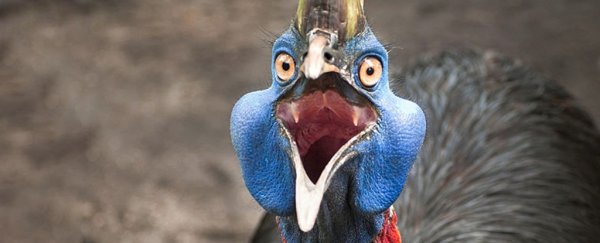With powerful legs tipped by dagger-like talons, capable of eviscerating you with a single kick, cassowaries are the bird that most lives up to the moniker of a modern dinosaur.
But surprisingly, these strikingly unique avians may have been humanity's 'chickens' – long before we kept actual chickens.
Eggshell remnants suggest that as far back as 18,000 years ago, humans seemed to be collecting cassowary eggs for something other than just a tasty meal.
"This is not some small fowl, it is a huge, ornery, flightless bird that can eviscerate you," Penn state anthropologist Kristina Douglass explained.
These hefty fruit eaters maintain their rainforest homes in Australia and Papua New Guinea, with many plants relying on them for germination, dispersal and fertilization of their seeds.
Some, like the cassowary plum (Cerbera floribunda), cannot propagate without these birds, and their gardening role is so critical, the decline of cassowaries is contributing to the shrinking of Australian rainforests.
Researchers studying how humans from the late Pleistocene to early Holocene managed their resources in Papua New Guinea's (PNG's) mountainous rainforests, discovered that these people harvested cassowary eggs far more than the adults of these birds. These were likely eggs from the dwarf cassowary, which weigh 20 kilograms (44 pounds) as adults.
 Cassowaries use their feet as weapons. (Dezidor/Wikimedia Commons/CC BY 3.0)
Cassowaries use their feet as weapons. (Dezidor/Wikimedia Commons/CC BY 3.0)
Douglass and colleagues constructed a model of eggshell development using 3D microscopy of ostrich eggs, to identify key characteristics across time. After successful tests with other bird species they were then able to apply this model to more than 1,000 cassowary eggshell fragments from PNG's National Museum and Art Gallery, collected by New Zealand archeologist Susan Bulmer.
"A large majority of the eggshells were harvested during late stages," said Douglass, concluding with her team that these people were intentionally harvesting eggs at the stage the embryos had fully formed limbs, beaks, claws and feathers.
"The eggshells look very late; the pattern is not random. They were either into eating baluts or they were hatching chicks."
Baluts are a street food in Asia – embryonic chicks that are cooked and eaten from the shell. While there were signs that some of the eggs had indeed been cooked and eaten, they were eggs from earlier in development – their shells retained burn patterns. The shell fragments from eggs that were closer to hatching, however, were much less likely to contain traces of having been cooked.
"There are enough samples of late stage eggshells that do not show burning that we can say they were hatching and not eating them," said Douglass.
"This behavior that we are seeing is coming thousands of years before domestication of the chicken."
Chickens were domesticated around 9,500 years ago, according to genetic evidence. So while it's highly improbable that humans ever domesticated cassowaries, this is now the earliest known example of humans rearing birds.
"These findings might radically alter the known timelines and geographies of domestication that tend to be the most widely understood and taught," Hunter College archeologist Megan Hicks, who was not involved in the study, told The New York Times.
"Where mammals are the best-known early cases (dogs and bezoar ibex), we now know that we need to be paying closer attention to human interactions with avian species."
Cassowaries are generally quite shy and prefer to avoid humans, but they are territorial and very dangerous if they feel threatened. Despite this, people in PNG today still raise and trade the birds, making use of their meat, bones, feathers and eggs. There's also a long historical record of these birds being traded.
"Cassowary chicks imprint readily to humans and are easy to maintain and raise up to adult size," the team writes in their paper.
 A modern day cassowary chick in PNG. (Andy Mack/Penn State University)
A modern day cassowary chick in PNG. (Andy Mack/Penn State University)
Humans reached this part of the world around 42,000 years ago; compared to the later impacts of farming, hunter-gatherers were thought to have had a relatively minimal impact on their environment. But this study suggests foraging communities did shape their environment in unexpected ways.
"Intergenerational knowledge of many Indigenous peoples, which indicates that traditional land owners and their ancestors have intentionally and intensively cultivated expansive landscapes, in some cases for millennia," the team writes.
Around the world, most ratites – the group of large flightless birds that also includes ostriches and elephant birds (Aepyornis maximus) – went extinct soon after humans arrived in their regions. Cassowaries are a rare exception.
The eggshell analysis used here has the potential to help us understand why many other large flightless birds did not make it, the team said.
For now, at least, cassowaries are still feasting on fruits in Australasian rainforests, making weird noises as they go.
This research was published in PNAS.
